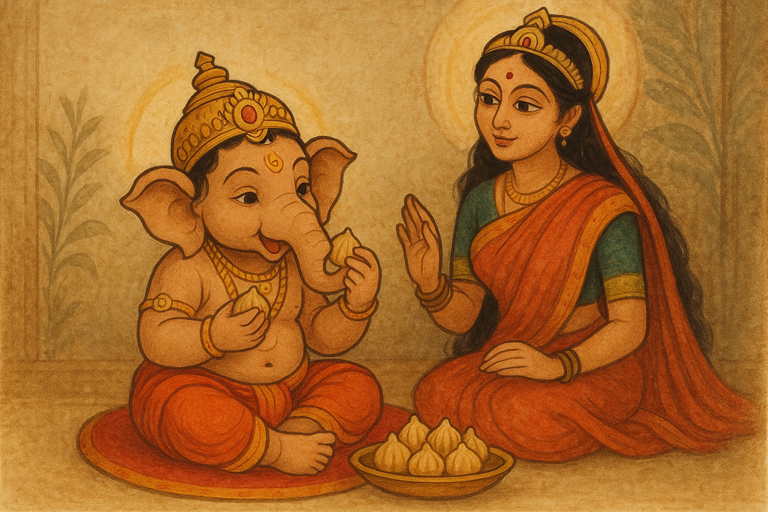In the vibrant tapestry of Indian festivals, few sights are as iconic as the platter of Modaks offered to Lord Ganesha. As the Vighnaharta (remover of obstacles) and the God of Wisdom, Lord Ganesha’s love for this sweet dumpling is legendary. The Modak is more than just a sweet; it is a symbol of devotion, a vessel of happiness, and a direct link to the divine.

At Mishticue.com, our passion lies in preserving the authenticity of India’s sweet heritage. While our specialty is Alwar Kalakand, we deeply admire the spiritual and cultural significance of sweets like the Modak, understanding that a truly authentic sweet is one made with purity, love, and a respect for tradition.
The Legend of the Divine Offering
One of the most famous Ganesha stories that explains his fondness for the Modak involves a celestial feast. The gods once presented a special Modak to Goddess Parvati, an ambrosial sweet with extraordinary powers. It was said that a single bite of this Modak would grant immense knowledge and wisdom to the one who consumed it.
Goddess Parvati, seeing her two sons, Ganesha and Kartikeya, both vying for the divine treat, decided to hold a competition. She declared that the one who would circle the universe and return first would be given the Modak. Kartikeya, swift and agile on his peacock, immediately set off on his journey around the world.
Ganesha, with his profound wisdom, realized that his parents represented his entire universe. Instead of embarking on a long journey, he simply circled his parents, Lord Shiva and Goddess Parvati, with deep reverence. Impressed by his ingenuity and unwavering devotion, Goddess Parvati declared Ganesha the winner, rewarding him with the divine Modak. From that day forward, the Modak became his favorite sweet, symbolizing the immense rewards of wisdom and humility over physical prowess.
The Symbolic Meaning Behind the Modak
Beyond its mythological origins, the Modak holds a deeper spiritual significance. The sweet filling inside the dumpling represents sat-chit-ananda (truth, consciousness, and bliss), while its outer covering represents the material body. The act of eating a Modak symbolizes the soul experiencing bliss by breaking through the shell of worldly existence.
Furthermore, the word Modak is derived from the Sanskrit word Moda, which means happiness or delight. By offering a Modak to Lord Ganesha, devotees are not only fulfilling his favorite sweet cravings but also seeking his blessings for a life filled with joy and prosperity.
The Prasad of Ganesh Chaturthi: A Symbol of Celebration
This special bond has made Modak the quintessential offering during ganesh chaturthi, the festive season celebrating the birth of Lord Ganesha. Devotees offer 21 Modaks as a sacred ritual, believing that it pleases the deity and invites his blessings into their homes. The tradition of making Modaks at home, with families gathering in the kitchen to shape the dumplings, adds to the joy and spiritual significance of the festival. This simple act of collective creation and offering is a powerful expression of faith and love.
A Shared Commitment to Purity: Mishticue’s Promise
While the Modak holds a special place in our hearts during Ganesh Chaturthi, our commitment at Mishticue.com is to honor the same principles of purity and tradition year-round. Just as the Modak is made with pure ghee and dedicated craftsmanship, our Alwar Kalakand is a testament to the same devotion. Every bite of our rich, grainy Kalakand is a slice of our heritage, crafted to perfection using traditional mithai methods.
We believe that the best sweets are those that carry a story of authenticity. Our Pan India delivery service ensures that you can experience the purest and most authentic taste of our sweets, no matter where you are.
Alwar Kalakand, authentic sweets, devotion, festive season, Ganesha stories, Ganesh Chaturthi, Lord Ganesha, Mishticue.com, Modak, traditional mithai

